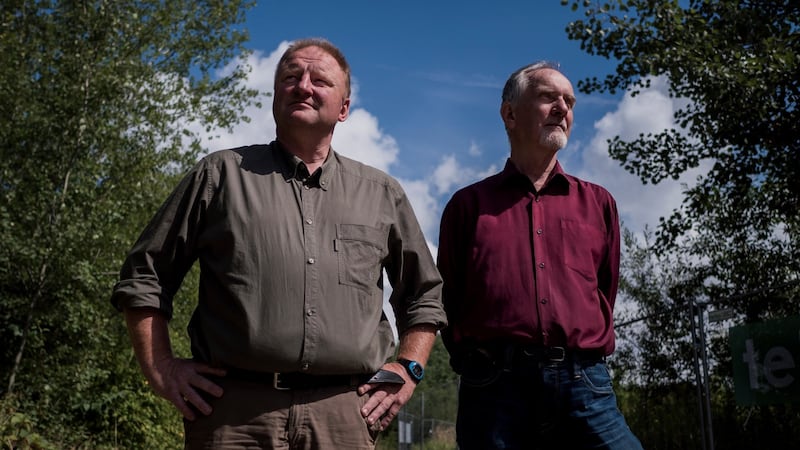A group of explorers has begun digging in southwestern Poland in a quixotic search for a buried Nazi train said to be filled with stolen gold, gems and artworks – despite experts' doubts that the train even exists.
The excavation, involving heavy equipment near a railway line between the cities of Walbrzych and Wroclaw, started nearly a year after two treasure seekers, Piotr Koper and Andreas Richter, created a frenzy by claiming that they had located the train. According to local lore, it disappeared in 1945 in a secret tunnel system as the Soviet Army advanced west toward Germany. Geologists and engineers at the Krakow University of Science and Technology expressed profound scepticism.
"We intend to find a railway infrastructure, an inlet to a railway tunnel, and inside this tunnel, we hope to find the train," Andrzej Gaik, a spokesman for the treasure hunters, told reporters at a news conference on Wednesday. "But what we will find on the train – that, we don't know."

The local authorities, who have grown somewhat wary of the hubbub since the initial rush of excitement, allowed the explorers to fence off the site, clear away rubble and cut down some trees, but not with public funds.
Koper, a Polish owner of a construction company, and Richter, a German geologist, have refused to be deterred. Over the last few months, they assembled a team of experts and collected the necessary permits to start the excavation process.
The highly anticipated search – involving 64 people, including engineers, geologists, chemists, archaeologists and a specialist in military demolitions – began on Friday and is expected to last at least 10 days.
Just before the digging began, six teams of surveyors used ground-penetrating radar to scan the site.
Two yellow earthmovers could be seen on Wednesday morning near the spot where the explorers believe the train is buried. From a nearby viaduct, several people observed the excavation.
Three sites
The explorers are focusing on three sites inside the fenced-off area.
Tomasz Siwiec
, the co-ordinator of the project, said that excavations of two of the sites had to be halted on Tuesday afternoon when the team encountered rocks that could be removed only by a jackhammer.
But during the third dig, Siwiec said, the team came across some materials that struck them as odd. “We have found pieces of decades-old porcelain, which may come from a porcelain factory that used to be here before the war, as well as some lake clay,” Siwiec said. “There are no lakes in the vicinity.” He speculated that the debris and clay had been used, along with dirt, “to bury the tunnel we are looking for.”
“We just intend to locate whatever there is to locate,” he said, “but getting it out rests with the Polish authorities.”
At the end of the second day of digging, Gaik and Adam Szynkiewicz, a geologist involved in the project, said that even though the excavators had gotten down to nine metres, they still had not found anything, showing that their initial estimates that the tunnel would be eight metres below ground, and the train nine metres below ground, had been too optimistic. "We will just have to go two to three metres deeper," Gaik said. "If we still have nothing at that depth, we will try another place."
Residents reacted with a mixture of curiosity and amusement. Anna Kreta (60), a retired postal worker from a nearby town, Swiebodzice, said she had heard legends of buried treasure since she was little. "It's not news to me, but it's still the number one topic for everyone," she said.
Walbrzych has been struggling with high unemployment since three coal mines closed in the 1990s.
“People here have suffered enough,” Kreta said. “Walbrzych deserves to find this gold train. This way, Walbrzych would become famous. People from all around the world would come to see the train. Tourism would flourish, and we would all be rich. This is the dream.”
Years of searches
Koper’s and Richter’s claim to have discovered the train’s location came after years of searches carried out over the decades, but it was taken seriously, at least at first. Last year, the deputy culture minister at the time,
Piotr Zuchowski
, said he felt “99 per cent certain” that the train had at last been found.
But Janusz Madej, a professor at the Krakow University of Science and Technology who led a team of experts who carried out surveys of the site in November, said it was a false hope. "There may be a tunnel, but there is no train," he said, adding, "It's human to make a mistake, but it's foolish to stand by it."
The area being excavated is part of Lower Silesia, which was German territory before 1945 and may still hide secrets from the wartime era. Many artworks and other valuables plundered from Eastern Europe were stashed in Silesian castles and mansions during the war and have not been accounted for.
New York Times










